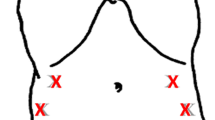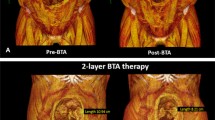Abstract
Background
Repair of complex ventral hernia can be very challenging for surgeons. Closure of large defects can have serious pathophysiological consequences. Botulinum toxin A (BTA) has recently been described to provide flaccid paralysis to abdominal muscles prior to surgery, facilitating closure and repair.
Methods
This was a prospective observational study of 32 patients who underwent ultrasound-guided injections of BTA to the lateral abdominal wall muscles prior to elective repair of complex ventral hernia between January 2013 and December 2015. Serial non-contrast abdominal CT imaging was performed to measure changes in fascial defect size, abdominal wall muscle length and thickness. All hernias were repaired laparoscopically or laparoscopic-assisted with placement of intra-peritoneal mesh.
Results
Thirty-two patients received BTA injections which were well tolerated with no complications. A comparison of baseline (preBTA) CT imaging with postBTA imaging demonstrated an increase in mean baseline abdominal wall length from 16.4 to 20.4 cm per side (p < 0.0001), which translates to a gain in mean transverse length of the unstretched anterolateral abdominal wall muscles of 4.0 cm/side (range 0–11.7 cm/side). Fascial closure was achieved in all cases, with no instances of raised intra-abdominal pressures or its sequelae, and there have been no hernia recurrences to date.
Conclusions
Preoperative BTA injection to the muscles of the anterolateral abdominal wall is a safe and effective technique for the preoperative preparation of patients prior to laparoscopic mesh repair of complex ventral hernia. This technique elongates and thins the contracted and retracted musculature, enabling closure of large defects.





Similar content being viewed by others
References
Deerenberg EB, Timmermans L, Hogerzeil DP, Slieker JC, Eilers PHC, Jeekel J, Lange JF (2015) A systematic review of the surgical treatment of large incisional hernia. Hernia 19:89–101
Slater NJ, Montgomery A, Berrevoet F, Carbonell AM, Chang A, Franklin M, Kercher KW, Lammers BJ, Parra-Davilla E, Roll S, Towfigh S, van Geffen E (2014) Criteria for definition of a complex abdominal wall hernia. Hernia 18:7–17
Flum DR, Horvath K, Koepsell T (2003) Have outcomes of incisional hernia repair improved with time? A population-based analysis. Ann Surg 237(1):129–135
Zendejas B, Khasawneh MA, Srvantstyan B, Jenkins DH, Schiller HJ, Zielinksi MD (2013) Outcomes of chemical component paralysis using Botulinum toxin for incisional hernia repairs. World J Surg 37:2830–2837
Smoot D, Zielinski M, Jenkins D, Schiller H (2011) Botox A injection for pain after laparoscopic ventral hernia: a case report. Pain Med 12:1121–1123
Barwood S, Baillieu C, Boyd R, Brereton K, Low J, Nattrass G, Graham HK (2000) Analgesic effects of Botulinum toxin A: a randomized, placebo-controlled clinical trial. Dev Med Child Neurol 42:116–121
Ibarra-Hurtado TR, Nuno-Guzman CM, Echeagaray-Herrera JE, Robles-Velez E, de Jesus G-JJ (2009) Use of botulinum toxin type A before abdominal wall hernia reconstruction. World J Surg 33:2553–2556
Ibarra-Hurtado TR, Nuno-Guzman CM, Miranda-Diaz AG, Troyo-Sanroman R, Navarro-Ibarra R, Bravo-Cuellar L (2014) Effect of Botulinum toxin A in lateral abdominal wall muscles thickness and length of patients with midline incisional hernia secondary to open abdomen management. Hernia 18:647–652
Zielinski MD, Goussous N, Schiller HJ, Jenkins D (2013) Chemical components separation with Botulinum toxin A: a novel technique to improve primary fascial closure rates of the open abdomen. Hernia 17:101–107
Dressler D (2012) Clinical applications of botulinum toxin. Curr Opin Microbiol 15:325–333
Farooque F, Jacombs AS, Roussos R, Read JW, Dardano AN, Edye M, Ibrahim N (2016) Preoperative abdominal muscle elongation with Botulinum toxin A for complex incisional ventral hernia repair. ANZ J Surg 86:79–83
Elstner KE, Jacombs ASW, Read JW, Rodriguez O, Edye M, Cosman PH, Dardano AN, Zea A, Boesel T, Mikami DJ, Craft C, Ibrahim N (2016) Laparoscopic repair of complex ventral hernia facilitated by pre-operative chemical component relaxation using Botulinum toxin A. Hernia. doi:10.1007/s10029-016-1478-6
Rosen MJ, Jin J, McGee MF, Williams C, Marks J, Ponsky JL (2007) Laparoscopic component separation in the single-stage treatment of infected abdominal wall prosthetic removal. Hernia 11:435–440
Author information
Authors and Affiliations
Corresponding author
Ethics declarations
Disclosures
Kristen E. Elstner, Omar Rodriguez-Acevedo, Peter H. Cosman, Anita S. W. Jacombs, Michael Edye, Aaron Zea, Tillman Boesel, Dean J. Mikami, and Nabeel Ibrahim declare no conflict of interest or financial ties to disclose. John W. Read declares conflict of interest related to the submitted work as he receives financial remuneration from Medicare as a radiologist. Anthony N. Dardano declares conflict of interest not directly related to the submitted work in the form of Honorarium from biomedical companies Cook, Synthes, and KCI.
Rights and permissions
About this article
Cite this article
Elstner, K.E., Read, J.W., Rodriguez-Acevedo, O. et al. Preoperative chemical component relaxation using Botulinum toxin A: enabling laparoscopic repair of complex ventral hernia. Surg Endosc 31, 761–768 (2017). https://doi.org/10.1007/s00464-016-5030-7
Received:
Accepted:
Published:
Issue Date:
DOI: https://doi.org/10.1007/s00464-016-5030-7




